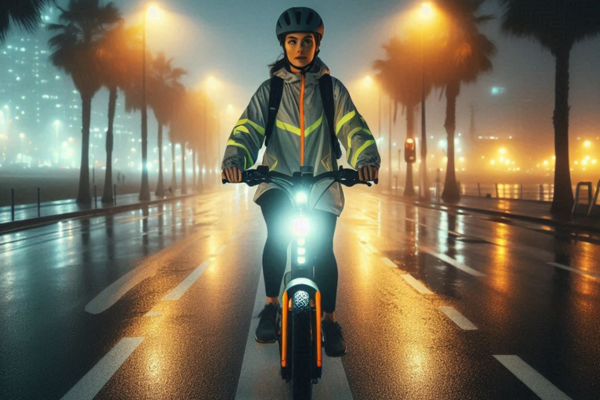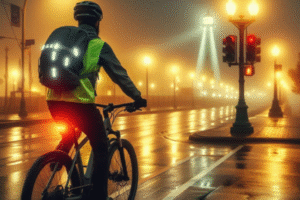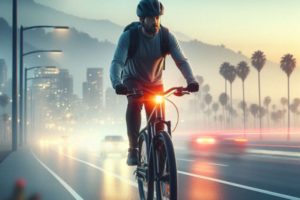🚫 The Invisible Cyclist: Why Visibility Mistakes Are the Most Dangerous
In coastal cities, electric bicycles have become the go-to solution for clean, fast, and flexible urban commuting. But one of the biggest threats to rider safety is often overlooked: e-bike visibility mistakes. Being invisible at night or in foggy seaside mornings is not just a minor inconvenience—it’s a life-threatening condition, and it happens more often than you’d think.
Most e-bike accidents involving cars happen because the driver never saw the cyclist until it was too late. Not because the rider wasn’t cautious, but because they made simple visibility mistakes that compounded in dangerous ways. In humid, coastal areas like Santa Marta, Lisbon, or San Francisco, this danger increases due to fog, rain, salt buildup, and unpredictable lighting conditions.
🌫️ Why Coastal Cities Make Riders Less Visible
The environment in coastal regions can sabotage even well-equipped riders. Moisture in the air softens light beams, sea salt fogs up lenses and reflectors, and shadows from palms or uneven lighting leave blind spots. Even with a light on your e-bike, you may be invisible from the side or rear.
- Morning mist blurs your silhouette to pedestrians and drivers.
- Salt particles dull reflectors and dim LED outputs.
- Wet asphalt creates glare that hides you in a beam of light.
And if you’re wearing dark clothing or relying only on a front light? You’re practically invisible from the sides, especially in corners or intersections.
🚨 The Most Common Mistake: Thinking “A Light is Enough”
One of the biggest mistakes e-bike riders make is assuming that one front light makes them visible enough. In truth, visibility is three-dimensional: front, back, and sides. Without reflective gear or multiple light sources, you’re only half visible—and that’s not good enough near traffic.
🧠 Real Story: Mateo’s Lesson in Cartagena
Mateo, a graphic designer who lives near Cartagena’s coast, used to ride home after work with just a front light on his e-bike. One evening, a car merged into the bike lane and clipped his back wheel. The driver said, “I saw a flash of light but thought it was a scooter.” Mateo now wears a reflective vest, LED ankle bands, and added a helmet light. “Now they know I’m a person, not a blur,” he says.
📉 The Risk of Not Being Seen
According to WHO road safety data, lack of visibility contributes to over 30% of night-time urban cycling collisions. And in coastal cities, that number is often underreported because conditions are so variable. The risk is not just in high-speed zones—it’s in intersections, turns, parking exits, and even crosswalks where e-bikes and cars mix paths.
💬 Are You Truly Visible?
Before your next ride, do this test: stand with your bike in a foggy or dimly lit area and ask someone to view you from 10 meters away—front, side, and back. Are you clearly visible? If not, this article is your first step to fixing that. Let’s uncover the top mistakes—and make sure you never become an invisible rider again.
“Being safe isn’t about riding slower. It’s about being seen sooner.” 🌙🚴♀️✨
💡 Visibility Failures: Common E-Bike Lighting Mistakes (and Why They Matter)
Lighting is the first line of defense for any e-bike commuter. But not all lights are created equal, and not every setup is effective—especially in the unpredictable, moisture-filled air of coastal cities. Most visibility-related accidents happen because riders assume that having a light means they’re safe. In reality, how you use your lights matters more than just having them.
🚨 Mistake #1: Using a Weak Front Light
A front light that barely lights up your path isn’t just ineffective—it’s dangerous. Coastal humidity and fog can cut your beam in half, and if your light isn’t powerful enough, drivers won’t see you until it’s too late.
- Minimum recommendation: 600 lumens, wide beam (90°+)
- Common error: Using underpowered clip-on lights meant for city parks or daylight
- Fix: Invest in IPX6 waterproof front lights designed for fog penetration
🔴 Mistake #2: Forgetting the Rear Light (or Using Only a Reflector)
Rear visibility is just as important as seeing ahead. Reflectors alone aren’t enough in a city like Valparaíso or Miami Beach, where glare from wet asphalt can make you disappear in car headlights.
- ✔ Always use at least one red LED rear light
- ✔ Dual setup (seatpost + backpack or helmet) increases depth perception for drivers
- ✔ Test your rear light after every wet ride—it may have salt or moisture inside
🟠 Mistake #3: No Side Visibility
Intersections, crosswalks, and driveways are the most common collision points in cities. If your bike is invisible from the side, you’re not protected. Most stock e-bike lights offer no lateral glow.
Simple fixes include:
- ✔ Spoke reflectors or spoke lights
- ✔ Side-mounted LED strips
- ✔ Reflective tire stripes (especially for foggy mornings)
🔧 Mistake #4: Poor Mounting or Loose Connections
Lights that wobble, tilt down, or bounce on cobblestone streets are more than annoying—they’re ineffective. Coastal roads often have uneven surfaces or sudden wind gusts, so you need secure, stable mounts.
- Never rely on elastic straps alone—use hard plastic or metal mounts
- Clean and tighten connections weekly (especially post-rain or post-beach)
- Use dielectric grease on charging ports to prevent corrosion
🧠 Real Story: Paula’s Wake-Up Call in Santa Cruz
Paula, a teacher from Santa Cruz, used to ride at night with a basic front light and a broken rear mount. One foggy evening, her back light failed without her noticing. A taxi nearly collided with her as she slowed for a turn. Since then, she upgraded to a dual rear setup and mounted her lights securely. “I never thought something so small could put me in so much danger,” she says.
📉 Lighting Mistake Summary
- 🚫 Weak front lights = low visibility in fog
- 🚫 No rear light = blind spot for traffic
- 🚫 No side visibility = vulnerable at crossings
- 🚫 Loose mounts = misaligned or lost lighting
“Your lights aren’t accessories. They are your voice on the road. Speak clearly.” 💡🌧️🚲
🧥 Clothing & Visibility: What You Wear Can Save Your Life
Lighting systems get a lot of attention—and rightly so—but your clothing and accessories can make or break your visibility on coastal night rides. The truth is, many e-bike commuters dress for comfort or style, but not for safety. In coastal cities, where mist, darkness, and salt blur the environment, every visible surface of your body counts.
🚫 Mistake #1: Wearing Dark or Non-Reflective Clothing
Black jackets, navy hoodies, and even dark grey sportswear might look sleek—but they absorb light rather than reflect it. In a coastal city like Havana or Seattle, a black raincoat in the fog makes you nearly invisible to side traffic.
Your fix? Think contrast:
- ✔ Neon colors like lime green, orange, coral, or highlighter yellow
- ✔ Reflective stripes placed on shoulders, arms, chest, and lower back
- ✔ Choose gear marked with ANSI/EN ISO 20471 compliance
If you can’t afford reflective gear, start small: add reflective tape to the back of your jacket, your shoes, and your gloves.
🦶 Mistake #2: Ignoring Moving Body Parts
Static light only does so much. Humans instinctively notice motion. That’s why adding reflectors to your wrists, ankles, and knees drastically increases your chances of being seen.
- Reflective ankle bands sync with your pedaling movement
- LED slap bands add both light and motion
- Wrist reflectors improve turn signals at intersections
A car approaching from behind or diagonally will notice moving reflectors much faster than a still light on your back.
🎒 Mistake #3: Overlooking Bags and Backpacks
Your backpack is the largest visual surface facing vehicles behind you—and many riders ignore it completely. A dark, unmarked bag covers reflective jackets and absorbs light.
- ✔ Use bags with built-in reflective patches or piping
- ✔ Add LED clips or wrap-around lights to straps or zippers
- ✔ Apply reflective stickers or decals if you already love your bag
Don’t waste the real estate—make it work for your safety.
🧠 Real Story: Adriana’s Outfit Shift in Guayaquil
Adriana used to bike home from night classes wearing a dark hoodie and black leggings. “I thought the bike lights were enough,” she said. After a close call near the marina, she started wearing a neon windbreaker, LED shoe clips, and reflectors on her backpack. “It’s like night and day—cars slow down sooner. They see me.”
📋 Clothing Visibility Mistake Recap
- 🚫 Dark clothes + no reflectors = invisible in coastal fog
- 🚫 No motion-based reflectors = poor detection by cars
- 🚫 Black backpacks = blocks your best safety gear
“Your body is a moving billboard. Use it to send one message: I am here. I am human.” 💛🦺🚴♀️
🧠 Behavior-Based Visibility: Strategic Mistakes Riders Don’t Realize They’re Making
Even with a bright light and reflective gear, many e-bike commuters remain partially invisible. Why? Because visibility isn’t just what you wear—it’s also how you ride. Strategic behavior on the road plays a crucial role in how clearly drivers can detect and interpret your presence.
Let’s break down the most common behavior-based visibility mistakes, especially in coastal cities where fog, reflections, and tight turns make it harder for others to predict your movements.
🧍♀️ Mistake #1: Riding Too Close to the Curb
Many cyclists hug the curb to avoid cars—but in doing so, they place themselves in shadow zones that make it harder to be seen, especially at night. Streetlights in coastal towns are often blocked by trees or fog, and reflective glare from wet sidewalks can obscure your outline.
- ✔ Ride slightly further into the lane (at least 1 meter from the curb)
- ✔ Take the lane when necessary to stay in better-lit areas
Remember: visibility beats politeness. If you’re not seen, you’re not safe.
🚫 Mistake #2: No Clear Hand Signals
In fog or rain, even bright lights aren’t enough—predictability is visibility. If drivers can’t guess your next move, they react slower. Many e-bike riders skip hand signals or use quick, unclear gestures that get lost in the dark.
- Extend your arm fully and hold the gesture for at least 3 seconds
- Use reflective gloves or wristbands to improve visibility
A clear signal can prevent dozens of near-misses at intersections and roundabouts.
🛣️ Mistake #3: Choosing the Shortest Route Instead of the Safest
It’s tempting to choose the fastest way home—but in coastal cities, that might mean riding through poorly lit boardwalks, industrial piers, or empty boulevards. These zones often lack traffic, lighting, or public presence—all of which reduce your visibility and safety.
Instead, try:
- ✔ Routes with ambient lighting and pedestrian activity
- ✔ Well-paved paths with dedicated bike lanes and stoplights
- ✔ Roads with shops or bus stops (drivers are more alert)
👁️ Mistake #4: Not Making Eye Contact with Drivers
In coastal towns with tourism or nightlife, drivers may be distracted or unfamiliar with local bike rules. Making eye contact at intersections can be the difference between being acknowledged or ignored.
If eye contact isn’t possible due to distance, slow down and increase your visibility posture: signal early, center your bike, and reduce sudden changes in direction.
🧠 Real Story: Gabriel’s Awareness Shift in San Sebastián
Gabriel commuted home from the marina each night through a coastal backroad. “It was quiet, scenic… and totally dark,” he says. After almost getting hit by a car exiting a hotel driveway, he rerouted through a more commercial zone. “I started making longer turns, stronger signals, and brighter gear choices. I was tired of being just a blur in the mist.”
📉 Behavioral Mistake Summary
- 🚫 Riding too close to the curb hides you in shadows
- 🚫 Weak or missing hand signals confuse drivers
- 🚫 Fastest route ≠ safest route at night
- 🚫 No communication = no reaction time from others
“Every action you take on the road is a signal. Make it bold, clear, and impossible to ignore.” 🚲🧠🌙
✅ How to Fix Visibility Mistakes: A Clearer Ride Starts Now
You’ve learned the top mistakes—from poor lighting setups to invisible outfits and unpredictable riding habits. Now let’s turn that awareness into action. Visibility isn’t about perfection—it’s about intention. These corrections are simple, affordable, and powerful. You don’t need to look like a traffic cone to stay safe—you just need to ride with purpose.
📋 Quick-Action Checklist: Visibility Essentials for Coastal E-Bike Riders
- ✔ 600+ lumen waterproof front light (wide beam)
- ✔ Dual rear red lights (seatpost + backpack or helmet)
- ✔ Reflective vest or jacket with ANSI/EN certification
- ✔ LED ankle and wrist bands for motion-based visibility
- ✔ Reflective tape on helmet, shoes, and bag
- ✔ Ride 1 meter away from the curb in poorly lit streets
- ✔ Use strong hand signals with reflective gloves
- ✔ Choose routes with ambient lighting and human activity
- ✔ Make eye contact with drivers at intersections
🧠 Real Story: Lucía’s Glow-Up in Montevideo
Lucía, a night-shift nurse in Montevideo, used to wear a grey windbreaker and rely on her e-bike’s built-in front light. One foggy night, she was nearly hit by a bus making a wide turn. “He said he never saw me,” she recalls. Since then, Lucía now wears a bright coral jacket, uses flashing wrist lights, and added spoke reflectors. “I get smiles and waves from other cyclists now. I feel seen—for real.”
❓ Frequently Asked Questions (FAQs)
1. Are flashing lights better than steady ones?
Flashing rear lights improve visibility, but steady beams are better for depth perception. A combination is ideal, but always check local regulations.
2. Can I just wear a reflective backpack instead of a vest?
You can—but it’s even better to combine both. A backpack can shift or cover your back. A vest adds consistent reflectivity that moves with your body.
3. Is it legal to ride in the middle of the lane?
In many cities, yes. Especially if the road is too narrow or unlit to ride safely near the curb. Visibility and safety take priority over staying “out of the way.”
4. What if I ride mostly in daytime?
Many coastal areas have foggy mornings and overcast afternoons. Visibility issues aren’t just a nighttime concern—ride visibly at all times.
5. What’s the cheapest way to improve visibility?
Reflective tape. Add it to your frame, pedals, backpack, helmet, and sleeves. It costs less than a coffee and could save your life.
💛 Final Thoughts: Visibility is a Form of Dignity
Being visible isn’t just about safety—it’s about identity. It says: “I deserve space. I have a right to be here.” In coastal cities where shadows, mist, and distractions are everywhere, you must be your own lighthouse.
“You’re not just a rider. You’re a presence. Shine like you mean it.” 🌟🚴♀️🌊
📣 Join the BrightMind9 Coastal Rider Community
Have you made a visibility change that improved your commute? Do you have tips, products, or routes to recommend to fellow riders in coastal cities? Share your voice in the comments—or tag us with your night gear setups. Together, we ride safer, smarter, and brighter. 💬💡
Also read: Night Riding on E-Bikes: Safety Tactics for Coastal City Commuters



